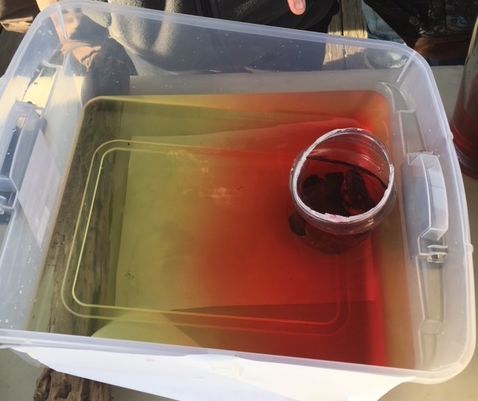SALTWATER WEDGE
Suggested Grades: 4-6
Driving Questions
- What is a saltwater wedge?
- Why does freshwater stay at the surface while salt water will travel up a river along the bottom in a wedge (because of density differences)?
- What are the water characteristics of an estuary, (from salty ocean water, to brackish, to fresh).
- How are animals and plants affected by a saltwater wedge in an estuary?
Learning Intentions
- I am aware of how salt and fresh water interact in an estuary
- I can share/teach this idea with others
Materials
- Clear plastic box or tote
- Small block
- Cool water
- Cool salty water
- Food colour (yellow for fresh water; red for salt water)
- White paper
- Paper cup
- Small stones
- https://oceanservice.noaa.gov/education/kits/estuaries/media/supp_estuar05a_wedge.html
- https://en.wikipedia.org/wiki/Saltwater_intrusion
Special Note:
To mix a seawater solution, add 35 grams of kosher salt (regular salt has additives) to 1 liter of water or approximately 1.2 ounces (2 scant tablespoons) of salt to 1 quart of water. To make a brackish mixture, halve the amount of salt Tint the fresh water and the salt water volumes with the food coloring before adding them to the tote.
Curricular Competencies
Science:
- Questioning and predicting
- Planning and conducting
- Processing and analyzing data and information
- Evaluating
- Communicating
Math:
- Communicating and representing
- Reasoning and analyzing
Lesson
- Place one end of the box or tote on a small block Place a piece of white paper under the box and fold the extra paper up along the back to produce a white background.
- Make several tiny holes in the bottom of the cup. Weight the cup with small stones and place at the lower end of the tote.
- Pour cool, fresh water (hint: tint it with yellow food colour) into the tote until it reaches close to the top of the cup. Allow the water to settle.
- Gently pour the cool, salty, red-tinted water into the cup (do not overfill).
- Describe what happens. (see photo below)
- Why?
Optional Activity: INVESTIGATING ESTUARIES
Estuaries are extremely valuable and productive areas. Research and report on why they are so valuable and what sorts of resources are found there.
- Take a field trip to an estuary. Test water samples from various parts of the estuary with a commercial hydrometer which measures salinity (the saltier the water the more dense it is and the higher the reading on the apparatus) .
Saltwater wedge demonstration: red water is saltwater (bottom) and yellow is the freshwater (top)
Click here to download a printable version of this lesson
This lessons pairs well with the Water Sampling Lesson.
Community Connection
This lessons is often part of a Down by the Bay Field Trip. Project Watershed can supply the materials for this lesson. Contact Project Watershed to arrange a field trip or the delivery of materials.


